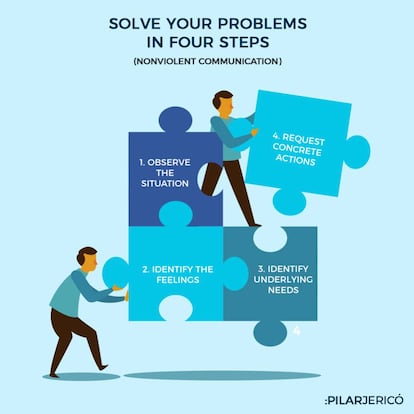Four steps to solving interpersonal problems
The art of nonviolent communication can save us a lot of grief when dealing with others
Sometimes conflict arises because we are not able to see what another person needs. When this happens, that person gets angry or becomes aggressive, although they may not know why. Quite simply, they stop talking to us, they yell at us or they behave in some other way which is part of their usual repertoire. In those moments, if we say “don’t get angry” the opposite happens. Therefore, finding a solution to a conflict requires a different way of communicating.

Marshall Rosenberg demonstrated this after working on incredibly complicated situations during the 1960s in the southern United States. Racial segregation reigned and acts of violence were frequent. To combat this, the psychologist developed a methodology called Nonviolent Communication (NVC), which allowed him to approach both sides and reduce the aggressiveness. That methodology can be applied in our day-to-day lives when we face a heated discussion or conflict.
NVC assumes that extreme anger, aggression and violence are expressions of the despair or helplessness of someone facing an unmet need. Therefore, an effective communicator must see beyond words, facts and emotions. They must pay attention to basic needs that exist and which are not satisfied, to achieve a sincere connection with the other person and with oneself. That is what the NVC proposes, which comprises four parts.
A restorative conversation does not consist of phrases that would put others on the defensive
The first phase consists of observing the situation without judgment, including both outside forces and what moves us from within. A restorative conversation would begin with disclosure without judgment. It does not consist of phrases that would put others on the defensive, such as “you work too much,” “you are a disaster,” or “you get angry at everything.” The idea is to start with something that cannot be questioned, such as: “When I talk about something important to me and you take out your phone to check your email...” If it is something that has happened, it cannot be denied.
The second stop is to identify the feelings that arise in both the parties involved. These can be both emotions and physical sensations. It is also useless to accuse the other person of thinking that they responsible for everything that happens to you, with phrases such as “because of you I feel terrible” or “I am very angry.” If you do, you must remember that the other person will put on a protective shield and the conversation will be over. The goal is to express what happens to us without judgment. If we continue with the example above, it would be “when I talk about something important to me and you take out your phone to check your email, it hurts me.”
When basic needs are not met, they are expressed in unfriendly emotions, such as fear, anger or sadness
The third phase is the most difficult of all because it means identifying underlying needs. We all need to feel loved, belong to a group, be recognized, and to feel autonomous. When these needs are not met, they are expressed in unfriendly emotions, such as fear, anger or sadness. Therefore, if we are able to further our understanding beyond feelings, we can bridge the gap and achieve more effective communication. If we go back to the example, the conversation could be: “When I talk about something important to me and you take out your phone to check your email, it hurts me because I need you to help me find a solution to my problem.”
The fourth phase is to propose a specific request to satisfy the unmet need. Here, it is necessary to speak clearly about your needs and not wait for the other person to take out a crystal ball and figure it out themselves. The above example would need the addition: “Therefore, as much as you can, I would like you to look at me while you listen and share your opinion.” Logically, what the other person does or says no longer depends on you. But this communication is more effective than saying directly: “Put down your phone already” or “you are such and such because you do not listen to me.”
In short, the NVC offers a method of more authentic conversation, without emotional baggage, and allowing you to resolve conflicts. If we are able to do follow these steps, we can save ourselves a lot of problems.
English version by Debora Almeida.
Tu suscripción se está usando en otro dispositivo
¿Quieres añadir otro usuario a tu suscripción?
Si continúas leyendo en este dispositivo, no se podrá leer en el otro.
FlechaTu suscripción se está usando en otro dispositivo y solo puedes acceder a EL PAÍS desde un dispositivo a la vez.
Si quieres compartir tu cuenta, cambia tu suscripción a la modalidad Premium, así podrás añadir otro usuario. Cada uno accederá con su propia cuenta de email, lo que os permitirá personalizar vuestra experiencia en EL PAÍS.
¿Tienes una suscripción de empresa? Accede aquí para contratar más cuentas.
En el caso de no saber quién está usando tu cuenta, te recomendamos cambiar tu contraseña aquí.
Si decides continuar compartiendo tu cuenta, este mensaje se mostrará en tu dispositivo y en el de la otra persona que está usando tu cuenta de forma indefinida, afectando a tu experiencia de lectura. Puedes consultar aquí los términos y condiciones de la suscripción digital.










































